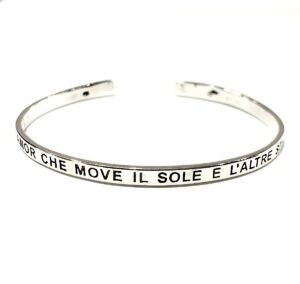
“Parole che risvegliano emozioni.
Parole che senti tue e che desideri condividere.
Parole come gioielli da indossare.” —”Gioielli di Pace, bracciale: ‘L’Amor che move il sole e l’altre stelle,'” Shanti Gioielli, (retrieved, March 20 2024)
Citings & Sightings of Dante's Works in Contemporary Culture

“Parole che risvegliano emozioni.
Parole che senti tue e che desideri condividere.
Parole come gioielli da indossare.” —”Gioielli di Pace, bracciale: ‘L’Amor che move il sole e l’altre stelle,'” Shanti Gioielli, (retrieved, March 20 2024)
Artists Gayle Fraas and Duncan Slade utilized machine and hand stitching techniques to create the above out of dye painted cotton and antique buttons. —Gayle Fraas and Duncan Slade, “Circle of Hell, why not?” Studio Art Quilt Associates, 2020 (retrieved March 20, 2024)
By Sofia Nuonno
“Paul Laffoley’s extraordinary triptych of Dante’s Comedy brings Dante’s ‘altro dove’ (literally, ‘other where’) into a remarkably comprehensive and vivid translation. In the history of illustrations of the Comedy, there is nothing like it. Laffoley is the only artist, as far as I know, to have depicted all one hundred cantos and the topography of Hell, Purgatory, and Paradise, in the same piece.
“With the classical, religious, mathematical, esoteric, and cosmo-logical themes present in Laffoley’s opus, Dante’s Comedy was a natural text for him to turn his attention. The Divine Comedy triptych, 1972-75 (plates 29, 30, and 31), indubitably bares his trademarks of architectonic precision, mind-boggling detail, immense erudition, symmetry, balance, and the word-techniques that lend themselves to an illustration of something as vast, multidimensional, intricate, and based in language and interpretation as Dante’s Comedy.” — Arielle Saiber, “Laffoley and Dante’s Other Worlds,” in The Essential Paul Laffoley, ed. Doug Walla (2016), 23-29.
By Sofia Nuonno
“Sergio Risaliti, director of the Museo Novecento in Florence and curator of the contemporary art section at the Museo e Real Bosco di Capodimonte in Naples, has seized on the importance of the anniversary to devise an ambitious project: a special edition of The Divine Comedy illustrated by artist Mimmo Paladino. The volume, published by Forma Edizioni, is enriched with essays by Cristina Acidini and Giorgio Bacci, as well as boasting the collaboration of Riccardo Bruscagli, an expert on Dante and professor emeritus of Italian literature at the University of Florence.
[…]
“How do the images connect with the words? What do they want to give back to the reader?
“Dante is a plastic and figurative poet; we could call him, today, a contemporary film director. In the Divine Comedy there are very powerful images that return a strong visual impact. We think of Paolo and Francesca, so overwhelmed by their love, embraced and entwined allinfinity, here Dante was writing making images alive. Paladino, taking his cue from Dante’s immense figurative repertoire, brings with his illustrations other solicitations, going beyond the limit of words and adding his portion of space and meaning.” — Antonio Mirabelli, “The Divine Comedy illustrated by Mimmo Paladino. Interview with the creator, Sergio Risaliti”, Finestre sull’Arte, March 23rd, 2021.
By Sofia Nuonno
“To mark the occasion of the 700th anniversary of the death of Italian poet and philosopher Dante Alighieri (1265–321) the Kupferstichkabinett is showing selections from two woodcut series from the 1920s.
“The series are by the Danish artist Ebba Holm and the German Klaus Wrage. Both deal in multifaceted ways with Dante’s literary magnum opus The Divine Comedy – and thereby with his virtual journey through hell, up the purgatorial mountain and on to paradise.” — “Hell’s Black and Starlight / Dante’s Divine Comedy in Modern and Contemporary Art”, Staatliche Museen zu Berlin, 1920s.
All submissions will be considered for posting. Bibliographic references and scholarly essays are also welcome for consideration.
Coggeshall, Elizabeth, and Arielle Saiber, eds. Dante Today: Citings and Sightings of Dante’s Works in Contemporary Culture. Website. Access date.